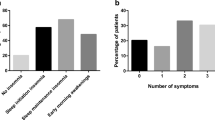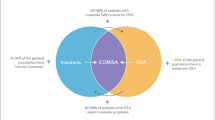Abstract
Objective: To assess an uncontrolled, open-label trial of sleep-disordered breathing (SDB) treatment on two different samples of chronic insomnia patients. Method: In Study 1 (Retrospective), data from one diagnostic and one continuous positive airway pressure (CPAP) titration polysomnogram were compiled from 19 chronic insomnia patients with SDB. Objective polysomnogram indicators of sleep and arousal activity and self-reported sleep quality were measured. In Study 2 (Prospective), clinical outcomes were assessed after sequential cognitive-behavioral therapy (CBT) and SDB therapy (CPAP, oral appliances, or bilateral turbinectomy) were provided to 17 chronic insomnia patients with SDB. Repeat measures included the Insomnia Severity Index, Functional Outcomes of Sleep Questionnaire, Pittsburgh Sleep Quality Index, and self-reported insomnia indices and CPAP use. Results: In Study 1, seven objective measures of sleep and arousal demonstrated or approached significant improvement during one night of CPAP titration. Sixteen of 19 patients reported improvement in sleep quality. In Study 2, Insomnia Severity Index, Functional Outcomes of Sleep Questionnaire, and Pittsburgh Sleep Quality Index improved markedly with CBT followed by SDB treatment and achieved an average outcome equivalent to curative status. Improvements were large for each treatment phase; however, of 17 patients, only 8 attained a nonclinical level of insomnia after CBT compared with 15 patients after SDB therapy was added. Self-reported insomnia indices also improved markedly, and self-reported SDB therapy compliance was high. Conclusions: In one small sample of chronic insomnia patients with SDB, objective measures of insomnia, arousal, and sleep improved during one night of CPAP titration. In a second small sample, validated measures of insomnia, sleep quality, and sleep impairment demonstrated clinical cures or near-cures after combined CBT and SDB therapies. These pilot results suggest a potential value in researching the pathophysiological relationships between SDB and chronic insomnia, which may be particularly relevant to patients with refractory insomnia.
Similar content being viewed by others
References
Bonnet MH, Arand DL. Diagnosis and treatment of insomnia. Respir Care Clin N Am 1999;5:333–348
American Psychiatric Association. Diagnostic and Statistical Manual of Mental Disorders (DSM-IV-TR). 4th ed, text revisionWashington, DC American Psychiatric Association 2000 597661
Nofzinger EA, Buysse DJ, Reynolds CFIII, Kupfer DJ. Sleep disorders related to another mental disorder (nonsubstance/primary): a DSM-IV literature review. J Clin Psychiatry 1993;54:244–255
Nowell PD, Buysse DJ, Reynolds CFIII et al. Clinical factors contributing to the differential diagnosis of primary insomnia and insomnia related to mental disorders. Am J Psychiatry 1997;154:1412–1416
Buysse DJ, Reynolds CFIII, Hauri PJ et al. Diagnostic concordance for DSM-IV sleep disorders: a report from the APA/NIMH DSM-IV field trial. Am J Psychiatry 1994;151:1351–1360
Hatoum HT, Kong SX, Kania CM, Wong JM, Mendelson WB. Insomnia, health-related quality of life and healthcare resource consumption. A study of managed-care organization enrollees. Pharmacoeconomics 1998;14:629–637
Kim K, Uchiyama M, Liu X et al. Somatic and psychological complaints and their correlates with insomnia in the Japanese general population. Psychosom Med 2001;63:441–446
Leger D, Scheuermaier K, Philip P et al. SF-36: evaluation of quality of life in severe and mild insomniacs compared with good sleepers. Psychosom Med 2001;63:49–55
Katz DA, McHorney CA. The relationship between insomnia and health-related quality of life in patients with chronic illness. J Fam Pract 2002;51:229–235
Lamarche CH, Ogilvie RD. Electrophysiological changes during the sleep onset period of psychophysiological insomniacs, psychiatric insomniacs, and normal sleepers. Sleep 1997;20:724–733
Bonnet MH, Arand DL. Physiological activation in patients with sleep state misperception. Psychosom Med 1997;59:533–540
Merica H, Blois R, Gaillard JM. Spectral characteristics of sleep EEG in chronic insomnia. Eur J Neurosci 1998;10:1826–1834
Bonnet MH, Arand DL. Heart rate variability in insomniacs and matched normal sleepers. Psychosom Med 1998;60:610–615
Morin CM. The nature of insomnia and the need to refine our diagnostic criteria. Psychosom Med 2000;62:483–485
Rosa RR, Bonnet MH. Reported chronic insomnia is independent of poor sleep as measured by electroencephalography. Psychosom Med 2000;62:474–482
Hall M, Buysse DJ, Nowell PD et al. Symptoms of stress and depression as correlates of sleep in primary insomnia. Psychosom Med 2000;62:227–230
Richardson GS, Roth T. Future directions in the management of insomnia. J Clin Psychiatry 2001;62(suppl):39–45
Perlis ML, Smith MT, Andrews PJ, Orff H, Giles DE. Beta/gamma EEG activity in patients with primary and secondary insomnia and good sleeper controls. Sleep 2001;24:110–117
Perlis ML, Kehr EL, Smith MT et al. Temporal and stagewise distribution of high frequency EEG activity in patients with primary and secondary insomnia and in good sleeper controls. J Sleep Res 2001;10:93–104
Vgontzas AN, Bixler EO, Wittman AM et al. Middle-aged men show higher sensitivity of sleep to the arousing effects of corticotropin-releasing hormone than young men: clinical implications. J Clin Endocrinol Metab 2001;86:1489–1495
Vgontzas AN, Bixler EO, Lin HM et al. Chronic insomnia is associated with nyctohemeral activation of the hypothalamic-pituitary-adrenal axis: clinical implications. J Clin Endocrinol Metab 2001;86:3787–3794
Shaver JL, Johnston SK, Lentz MJ, Landis CA. Stress exposure, psychological distress, and physiological stress activation in midlife women with insomnia. Psychosom Med 2002;64:793–802
Morin C. Insomnia: Psychological Assessment and ManagementNew York, NY Guilford Press 1993 915
Edinger JD, Wohlgemuth WK, Radtke RA, Marsh GR, Quillian RE. Cognitive behavioral therapy for treatment of chronic primary insomnia: a randomized controlled trial. JAMA 2001;285:1856–1864
Thase ME. Antidepressant treatment of the depressed patient with insomnia [review]. J Clin Psychiatry 1999;60(suppl 17):28–31 discussion 46–48
Murtagh DR, Greenwood KM. Identifying effective psychological treatments for insomnia: a meta-analysis. J Consult Clin Psychol 1995;63:79–89
Chesson AL, Jr, Anderson W M, Littner M et al. Practice parameters for the nonpharmacologic treatment of chronic insomnia. An American Academy of Sleep Medicine report. Standards of Practice Committee of the American Academy of Sleep Medicine. Sleep 1999;22:1128–1133
Morin CM, Hauri PJ, Espie CA et al. Nonpharmacologic treatment of chronic insomnia. An American Academy of Sleep Medicine review. Sleep 1999;22:1134–1156
Lichstein KL, Wilson NM, Johnson CT. Psychological treatment of secondary insomnia. Psychol Aging 2000;15:232–240
Lichstein KL, Riedel BW, Wilson NM, Lester KW, Aguillard RN. Relaxation and sleep compression for late-life insomnia: a placebo-controlled trial. J Consult Clin Psychol 2001;69:227–239
Espie CA, Inglis SJ, Harvey L. Predicting clinically significant response to cognitive behavior therapy for chronic insomnia in general medical practice: analysis of outcome data at 12 months posttreatment. J Consult Clin Psychol 2001;69:58–66
Harvey L, Inglis SJ, Espie CA. Insomniacs’ reported use of CBT components and relationship to long-term clinical outcome. Behav Res Ther 2002;40:75–83
American Academy of Sleep Medicine. The international classification of sleep disorders. Lawrence, Kansas Allen Press Inc. 1997, 52–58
Krakow B, Germain A, Tandberg D et al. Sleep breathing and sleep movement disorders masquerading as insomnia in sexual assault survivors with PTSD. Compr Psychiatry 2000;41:49–56
Krakow B, Artar A, Warner TD, et al. Sleep disorder, depression, and suicidality in female sexual assault survivors. Crisis 2000;21:163–170
Krakow B, Germain A, Warner TD, et al. The relationship of sleep quality and posttraumatic stress to potential sleep disorders in sexual assault survivors with nightmares, insomnia and PTSD. J Trauma Stress 2001;14:647–665
Krakow B, Melendrez D, Santana E, et al. Prevalence and timing of sleep disturbance in Cerro Grande Firestorm victims. Sleep 2001 24(suppl) A394
Krakow B, Hollifield M, Johnston L, et al. Imagery rehearsal therapy for chronic nightmares in sexual assault survivors with posttraumatic stress disorder: a randomized controlled trial. JAMA 2001;286:537–545
Krakow B, Johnston L, Melendrez D, et al. An open-label trial of evidence-based cognitive behavioral therapy for nightmares and insomnia in crime victims with PTSD. Am J Psychiatry 2001;158:2043–2047
Krakow B, Melendrez DC, Johnston LG, et al. Sleep dynamic therapy for Cerro Grande Fire evacuees with posttraumatic stress symptoms: a preliminary report. J Clin Psychiatry 2002;63:673–684
Krakow B, Lowry C, Germain A, et al. A retrospective studyon improvements in nightmares and posttraumatic stress disorder following treatment for co-morbid sleep-disordered breathing. J Psychosom Res 2000;49:291–298
Melendrez D, Krakow B, Johnston L, Sisley B, Warner TD. A prospective study on the treatment of “complex insomnia”—insomnia plus sleep-disordered breathing—in a small series of crime victims with PTSD, Sleep 2001. 24(suppl) A120
Krakow B, Melendrez D, Johnston L, et al. Sleep-disordered breathing, psychiatric distress, and quality of life impairment in sexual assault survivors. J Nerv Ment Dis 2002;190:442–452
American Academy of Sleep Medicine. Sleep-related breathing disorders in adults: recommendations for syndrome definition and measurement techniques in clinical research. The Report of an American Academy of Sleep Medicine Task Force. Sleep 1999;22:667–689
Krakow B, Melendrez D, Ferreira E, et al. Prevalence of insomnia symptoms in sleep-disordered breathing patients. Chest 2001;120:1923–1929
Krakow B, Melendrez D, Warner TD, et al. To breathe, perchance to sleep: sleep-disordered breathing and chronic insomnia among trauma survivors. Sleep Breath 2002;6:189–202
Chung KF, Krakow B, Melendrez D, Warner TD, Sisley B. Relationships between insomnia and sleep-disordered breathing [letter] Chest, 2003. 123:310–313
Namen AM, Dunagan DP, Fleischer A, et al. Increased physician-reported sleep apnea: the National Ambulatory Medical Care Survey. Chest 2002;121:1741–1747
Ohayon MM, Roth T. What are the contributing factors for insomnia in the general population?. J Psychosom Res 2001;51:745–755
Guilleminault C. Clinical features and evaluation of obstructive sleep apnea. In: Kryger MH, Roth T, Dement WC, Principles and Practice of Sleep Medicine. 2nd ed. London, WB Saunders Co. 1994, 552–558
Krakow B, Melendrez D, Pedersen B, et al. Complex insomnia: insomnia and sleep-disordered breathing in a consecutive series of crime victims with nightmares and PTSD. Biol Psychiatry 2001;49:948–953
Hosselet JJ, Norman RG, Ayappa I. Detection of flow limitation with a nasal cannula/pressure transducer system. Am J Respir Crit Care Med 1998;157:1461–1467
Montserrat JM, Farre R, Ballester E, et al. Evaluation of nasal prongs for estimating nasal flow. Am J Respir Crit Care Med 1997;155:211–215
Guilleminault C, Stoohs R, Duncan S. Snoring (I). Daytime sleepiness in regular heavy snorers. Chest 1991;99:40–48
ResMed. AutoSet Portable 2 Plus Overview and Interpretation Guide. San Diego, CA. Res Med. 1998
Gugger M. Comparison of ResMed AutoSet (version 3.03) with polysomnography in the diagnosis of the sleep apnoea/hypopnoea syndrome. Eur Respir J 1997;10:587–591
Exar EN, Collop NA. The upper airway resistance syndrome. Chest 1999;115:1127–1139
Ayappa I, Norman RG, Krieger AC, et al. Non-invasive detection of respiratory effort-related arousals (RERAs) by a nasal cannula/pressure transducer system. Sleep 2000;23:763–771
Liam CK. A portal recording system for the assessment of patients with sleep apnoea syndrome. Med J Malaysia 1996;51:82–88
Guilleminault C, Palombini L, Poyares D. Chronic insomnia, postmenopausal women, and sleep-disordered breathing. Part 1. Frequency of sleep-disordered breathing in a cohort. J Psychosom Res 2002;53:611–615
Guilleminault C, Palombini L, Poyares D, Chowdhuri S. Chronic insomnia, postmenopausal women and sleep-disordered breathing. Part 2. Comparison of nondrug treatment trials in normal breathing and UARS postmenopausal women complaining of chronic insomnia. J Psychosom Res 2002;53:617–623
Grunstein R, Sullivan C. Continuous positive airway pressure for sleep breathing disorders In: Kryger MH, Roth T, Dement WC, Principles and Practice of Sleep Medicine. 3rd ed. Philadelphia, WB Saunders Co. 2000. 894–912
McGregor P, Thorpy MJ, Schmidt-Nowara WW, Ledereich PS, Snyder M. T-sleep: an improved method for scoring breathing-disordered sleep. Sleep 1992;15:359–363
Bastien CH, Vallieres A, Morin CM. Validation of the Insomnia Severity Index as an outcome measure for insomnia research. Sleep Med 2001;2:297–307
Weaver TE, Laizner AM, Evans LK, et al. An instrument to measure functional status outcomes for disorders of excessive sleepiness. Sleep 1997;20:835–843
Buysse D, Reynolds C, III, Monk T, Berman SR, Kupfer DJ. The Pittsburgh Sleep Quality Index: a new instrument for psychiatric practice and research. Psychiatry Res 1989;28:193–213
Morin CM, Blais F, Savard J. Are changes in beliefs and attitudes about sleep related to sleep improvements in the treatment of insomnia?. Behav Res Ther 2002;40:741–752
Morin CM, Colecchi C, Stone J, Sood R, Brink D. Behavioral and pharmacological therapies for late-life insomnia: a randomized controlled trial. JAMA 1999;281:991–999
Saletu B, Klosch G, Gruber G, et al. First-night-effects on generalized anxiety disorder (GAD)-based insomnia: laboratory versus home sleep recordings. Sleep 1996;19:691–697
Author information
Authors and Affiliations
Corresponding author
Rights and permissions
About this article
Cite this article
Krakow, B., Melendrez, D., Lee, S.A. et al. Refractory Insomnia and Sleep-Disordered Breathing: A Pilot Study. Sleep Breath 8, 15–29 (2004). https://doi.org/10.1007/s11325-004-0015-5
Issue Date:
DOI: https://doi.org/10.1007/s11325-004-0015-5




